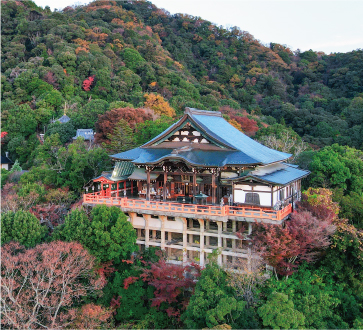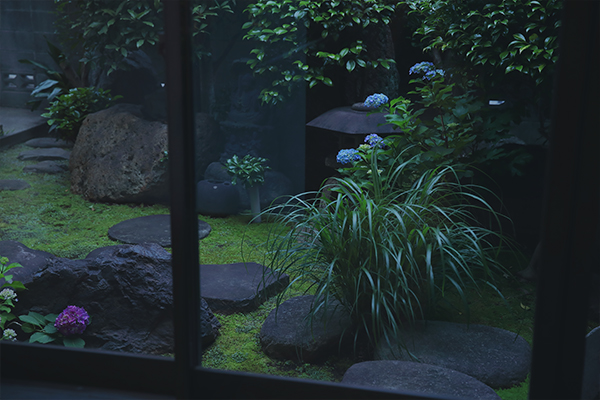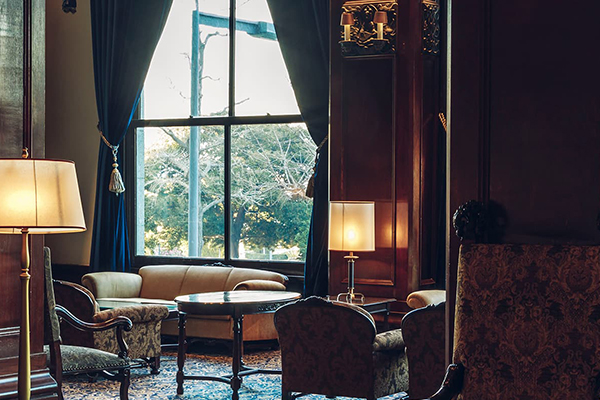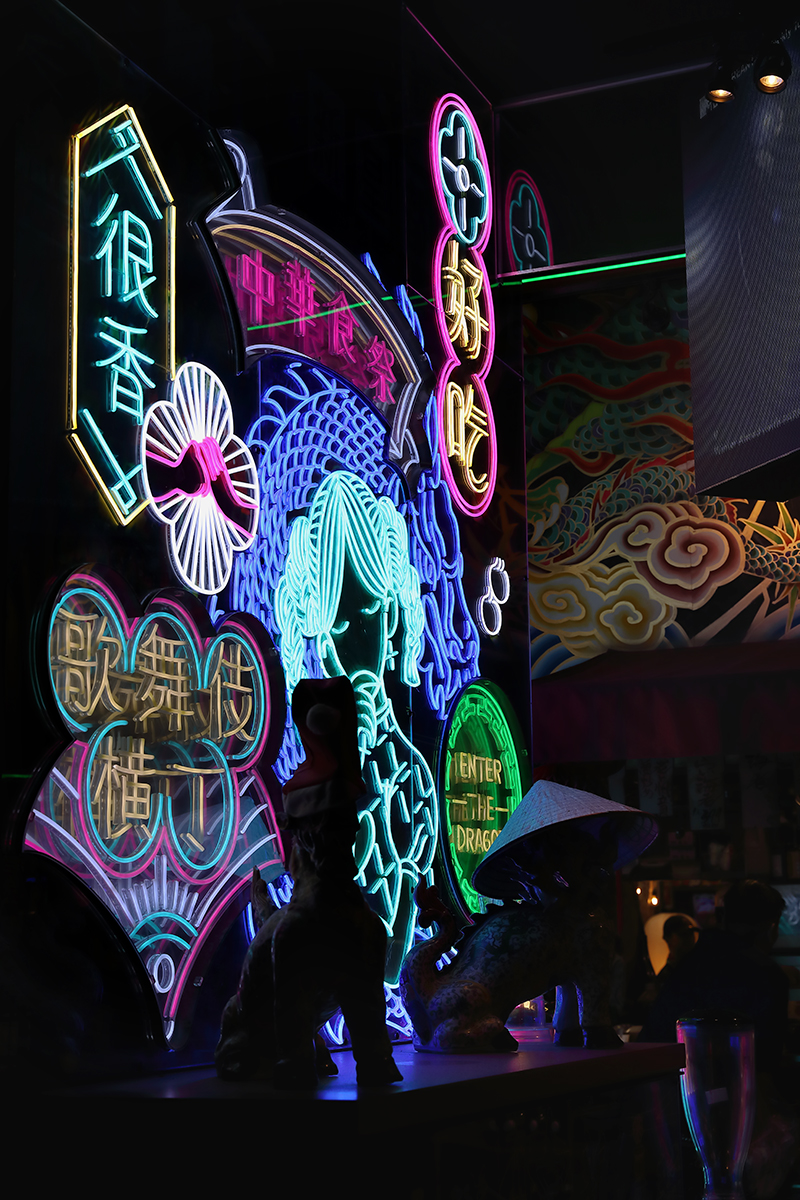
インバウンドの中身。
インバウンドの中身。
訪日客は日本のどこを見ているのか、という話。

観光立国を目指す日本には、 その思惑どおり多くの外国人が観光にやってきている。 最多は韓国、そして中国、台湾とつづく。 欧米人も増えていて、浅草あたりを歩いていると フランス語やイタリア語をよく耳にする。 こうして街が国際色豊かになる一方で オーバーツーリズムという問題も起きている。 外国人観光客はどこへ行き、なにを見ているのか? そこを探ってみた今号のyoff。 この号を読んでインバウンドについて 考えてもらえるとうれしいです。
インバウンドの中身。
Feature | 2025.1.24
訪日客は日本のどこを見ているのか、という話。
観光立国を目指す日本には、
その思惑どおり多くの外国人が観光にやってきている。
最多は韓国、そして中国、台湾とつづく。
欧米人も増えていて、浅草あたりを歩いていると
フランス語やイタリア語をよく耳にする。
こうして街が国際色豊かになる一方で
オーバーツーリズムという問題も起きている。
外国人観光客はどこへ行き、なにを見ているのか?
そこを探ってみた今号のyoff。
この号を読んでインバウンドについて
考えてもらえるとうれしいです。
What are visitors to Japan looking at?
Japan, aiming to become a tourism-driven nation, is attracting many foreign visitors,
with the largest numbers from South Korea,
China, and Taiwan.
Western tourists are also on the rise, and strolling through areas like Asakusa,
it’s not uncommon to hear French or Italian.
While this international vibrancy enriches cities, overtourism is emerging as a concern.
This edition of yoff explores
where tourists go and what they see,hoping to inspire thoughts on the impact of inbound tourism.
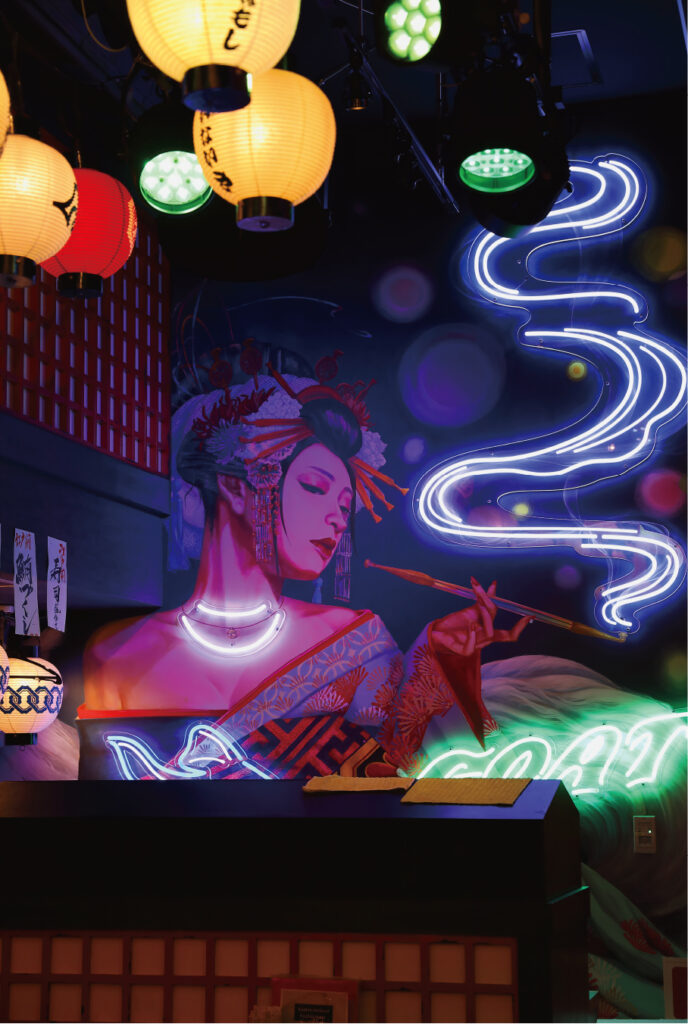
インバウンドが活気づいている。
円安の要因もあり2024年1月〜11月の訪日客は3337万人以上。通年で過去最高だった3188万2000人をすでに超えた。政府は2030年に6000万人を目指すといっている。
それでなくてもいま、オーバーツーリズムが問題になっているのに。
日本にやって来る外国人観光客はどういう過ごし方をしているのか。
インバウンドの中身を覗いてみた。
Inbound tourism is thriving, with over 33.37 million visitors from January to November 2024,
surpassing the previous annual record of 31.882 million.
The government has announced the goal of reaching 60 million visitors by 2030,
but overtourism is already a concern.
How are foreign tourists spending their time in Japan?
Let’s investigate inbound tourism.
世界中でオーバーツーリズムが止まらない。世界の国際観光客到着数は、2024年7月現在ですでにコロナ禍前の水準の96%となっている。観光地は国を超えて続々とやってくる想定外の観光客に悲鳴をあげ、各都市では様々な規制が始まっている。
例えば、バリ島はホテルの新規建設を一時停止すると発表。バルセロナはAirbnbなどで利用される住宅の短期賃貸を2028年まで全面禁止する予定。ベネチアは日帰り観光客から5ユーロの入場料を徴収。他にもマヨルカ島やリスボン、シチリア、パリ、さらにはエベレストにいたるまで、多くの観光地がオーバーツーリズムの影響で住環境、自然環境が損なわれ、物価や住宅価格が上がり、ゴミ問題が起き、憤慨した地元住民たちによるデモがおこなわれている。
日本でも外国人観光客が爆増。2024年10月の訪日外客数は3,312,000人で、前年同月比31,6%増。過去最速で3,000万人を突破している。
インバウンドに詳しいあるメディアによると、訪日客の人気スポットは京都や浅草などの有名観光地だけではないようだ。人気ランキングのベスト30を見ると秋葉原の「フクロウカフェ」や京都の「サムライ剣舞シアター」、大阪の「マジックバー フレンチドロップ」、三重県の「なばなの里」といった日本人でもあまり知らない場所が多くある。
外国人たちはどこで情報を仕入れて、何をしにそこへ行くのか。もしかしたらそこには、日本人が知らない、日本の楽しみ方があるのかもしれない。ということで訪日客に人気の「新宿カブキhall〜歌舞伎横丁」、「スナックツアー」、そして「玉蔵院」を訪ねてみた。すると、インバウンドの中身が少し見えるかも。
Overtourism continues to grow unchecked worldwide. As of July 2024, international tourist arrivals globally have already reached 96% of pre-pandemic levels. Overwhelmed destinations are responding with new regulations.
Bali has paused new hotel construction, Barcelona plans to ban short-term rentals until 2028, and Venice is charging day-trippers a 5-euro entry fee. Other destinations like Mallorca, Lisbon, Sicily, Paris, and Mount Everest face overtourism’s effects, including environmental damage, rising costs, waste issues, and local protests.
Japan too is experiencing a surge in foreign tourists. In October 2024, 3.312 million visitors arrived in Japan, a 31.6% increase compared to the same month the previous year. The number of visitors topped 30 million earlier in the year than ever before.
Inbound tourism media reveal that popular spots extend beyond famous destinations like Kyoto or Asakusa. The top 30 list includes lesser-known attractions such as Akihabara’s Owl Café, Kyoto’s Samurai Kembu Theater, Osaka’s Magic Bar French Drop, and Nabana no Sato in Mie Prefecture.
Where do visitors find their information, and what attracts them to these spots? Perhaps they’ve discovered ways to enjoy Japan unfamiliar even to locals. With this in mind, I explored popular tourist spots—Shinjuku Kabuki Hall – Kabuki Yokocho, a snack bar tour, and Gyokuzoin Temple—for insights into inbound tourism.



日本らしさを詰め込んだ、食とお祭りの空間に遊ぶ外国人たち。
Feature | 2025.1.24
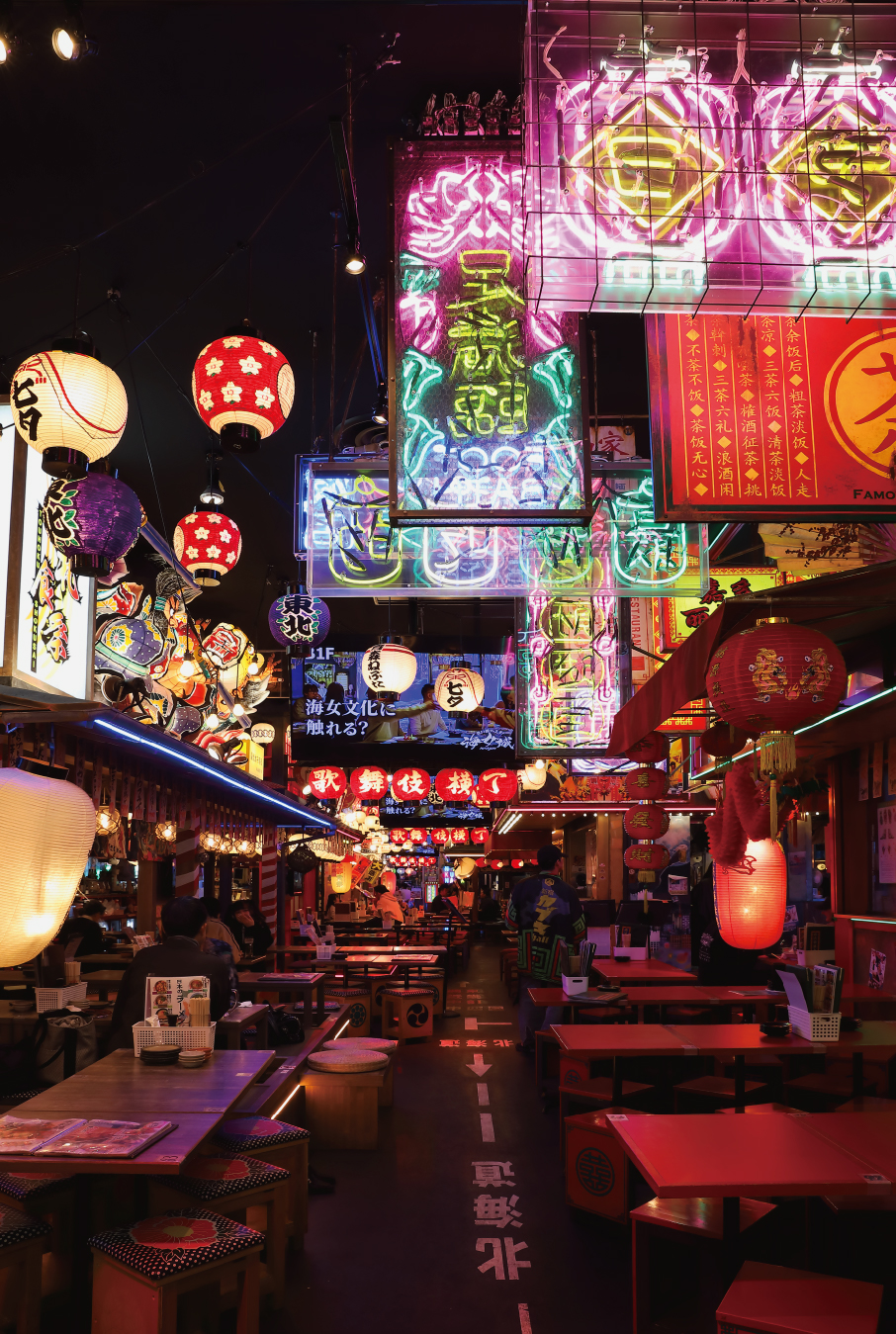
新宿カブキhall~歌舞伎横丁
新宿歌舞伎町という刺激ある街に、
サイバーな雰囲気の“横丁”がある。
そこに今夜もインバウンド客がやって来る。
訪日客たちに人気の新宿。ゴールデン街、思い出横丁、歌舞伎町といった場所に外国人たちが集まってくる。そんな新宿のなかで特に目を惹くのが「新宿カブキhall〜歌舞伎横丁」。ここは「恵比寿横丁」や「渋谷横丁」といった “横丁” ブームの仕掛け人である浜倉好宣さんが手がけた店。都内にいくつかある “横丁” のなかでもここ「歌舞伎横丁」では訪日客を多く見かける。どうしてなのか。そのあたりのことを浜倉好宣さんの長男で株式会社浜倉的商店製作所 カブキhall支配人の浜倉秀さんにおうかがいした。
そもそも海外のお客さんの割合はどれくらいですか。「今は6割は海外の方です。私どもの『歌舞伎横丁』がある『東急歌舞伎町タワー』は東急さんがエンターテインメントビルとしてつくったものでターゲットにはインバウンドの方も入っています。3階の『ナムコ アミューズメントコンプレックス』のアニメやキャラクターものは海外の方から人気で、そこから2階の『歌舞伎横丁』でお食事〜お酒というのが流れですね。あと、タワー上層階のホテルから下りてくるお客さまも多くいらっしゃいます」。
気になるのは店の内装。日本人でも楽しいというか、ワクワクするというか。「祭りとエンタメの昭和な横丁文化を表現しています。その空間に、北海道から九州といった日本各地、さらには韓国の食も楽しめる多彩な店が集まった次世代エンターテインメントフードホールです」。
さまざまな食習慣をもった方がいらっしゃいます。トラブルはありませんか。「強いていうならば、お通しですね。お通しは日本の居酒屋特有の習慣。海外のお客さんのなかには “こんなの注文していないからお金は払いたくない” という方もいらっしゃいます。あとは時々ですが、定員が着ているハッピやビールメーカーのTシャツが欲しいとかジョッキは買えないかなどと言われることはあります。ハッピはその場で羽織ってもらい写真を撮って喜んでもらっています」。
インバウンドの方を通しての仕事の楽しみは何ですか。「日本の食とともに祭りという文化に触れてもらうことです。あとはコミュニケーションですね。店内にある各地の祭りをテーマにした装飾のひとつひとつに興味をもち、これは何?とたずねてくる。また、メニューの内容を聞いてくることもあります。すると若い定員たちが臆することなく答えている。言葉ができなくても翻訳機を使って。そうしてコミュニケーションが生まれることが楽しいですね」。なるほど、コミュニケーションは居酒屋に不可欠なもの、それがインターナショナルに広がっている。
「平均して1〜2週間の滞在が訪日客の目安。その間、1回だけでもここ『歌舞伎横丁』で食事をしてもらいたい」と語る浜倉さん。その意気込みからすると、これからまだまだ新宿に訪日客が増えそうだ。
Foreign visitors delight in places rich with Japanese essence,
where cuisine and festive traditions come together.
In Shinjuku’s lively Kabukicho district,
a cyber-inspired yokocho (alleyway) draws inbound tourists once again tonight.
Shinjuku remains a top destination, drawing crowds to places like Golden Gai, Omoide Yokocho, and Kabukicho. Among these, Shinjuku Kabuki Hall – Kabuki Yokocho, created by Yoshinobu Hamakura, the mastermind behind the yokocho boom with spots like Ebisu Yokocho and Shibuya Yokocho, stands out. What makes it so appealing, particularly among inbound tourists? We spoke with Shu Hamakura, son of Yoshinobu Hamakura and manager of Kabuki Hall at Hamakura Produce Inc., for insights. What percentage of your customers are from overseas? “Currently, 60% of our customers are from abroad. Our ‘Kabuki Yokocho’ is in the Tokyu Kabukicho Tower, an entertainment complex catering to inbound tourists. The third-floor ‘Namco Amusement Complex,’ with its anime and character-themed attractions, draws foreign visitors, who often dine and drink at the second-floor ‘Kabuki Yokocho.’ Many guests also come from the tower’s upper-floor hotels.” The interior design is striking, appealing even to Japanese visitors.”We showcase retro Showa-era yokocho culture, blending festivals and entertainment. The space is a next-generation entertainment food hall with various eateries offering dishes from Hokkaido to Kyushu, and even Korea.” What dishes are most popular among foreign visitors? “Wagyu, sushi, and tempura are natural favorites. Ramen, karaage, gyoza, and yakitori are also popular, with all four available at various eateries here.”
Given the variety of dietary habits, have there been any issues?
“If anything, it’s otoshi. This complimentary appetizer at izakayas can confuse foreign guests who say, ‘I didn’t order this and don’t want to pay for it.’ Occasionally, they ask to buy happi coats worn by the staff, beer-branded T-shirts, or mugs. We let them try on the happi coats for photos, which they enjoy.” What do you enjoy most about working with inbound tourists?”Sharing Japanese food and festival culture is a joy, but it’s the communication that stands out. Guests are curious about our festival-themed decorations and often ask about them or the menu. Our young staff confidently respond, using translation devices when needed. These connections are truly rewarding.”
Indeed, communication is vital in izakayas, and it’s inspiring to see it transcending borders.
“Most inbound tourists stay in Japan for one to two weeks. I hope they’ll visit Kabuki Yokocho at least once during their stay,” says Hamakura. With such passion, Shinjuku is sure to draw even more foreign visitors.
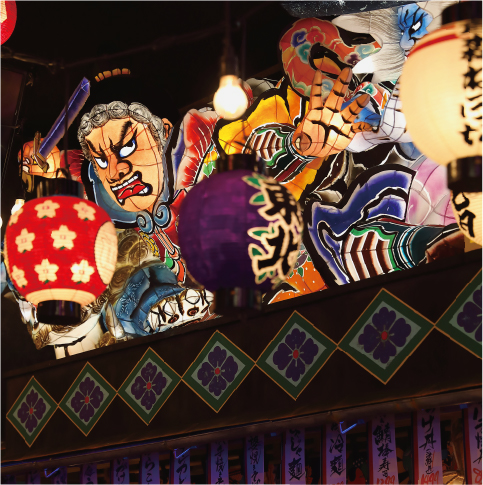
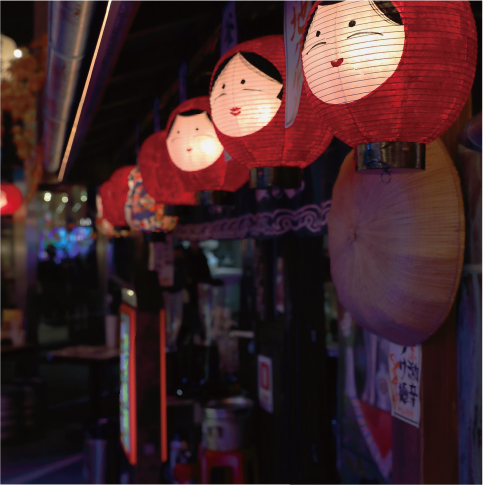
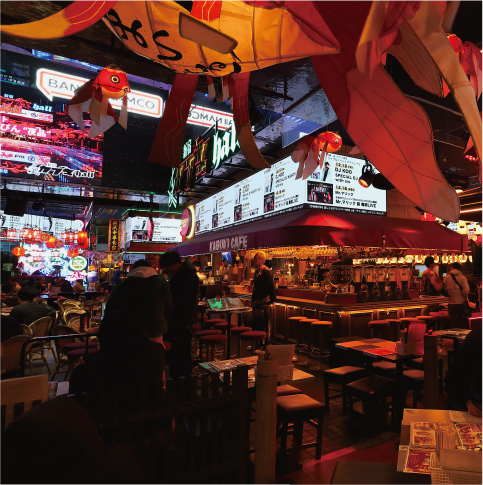
株式会社浜倉的商店製作所
カブキhall支配人_浜倉 秀 氏


《新宿カブキhall~歌舞伎横丁》
https://kabukihall.com/
西武新宿線「西武新宿駅」から徒歩1分
年中無休 ※年末年始も通常営業。
外国人スナックツアーに参加して、ディープな日本が好きになる。
Feature | 2025.1.24
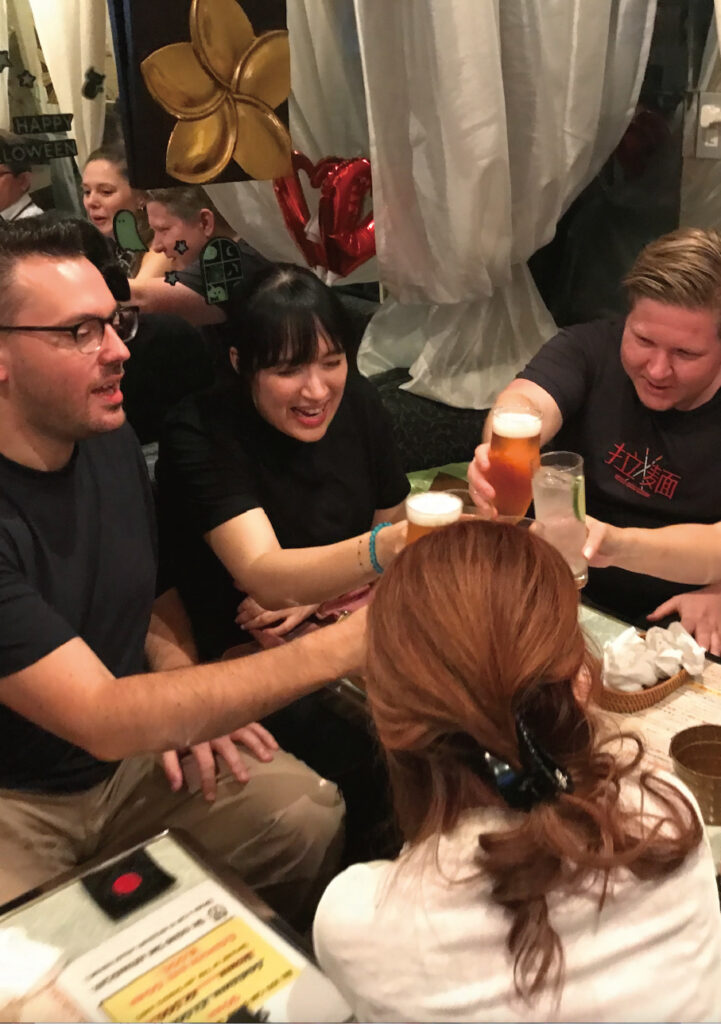
少し重めの扉を開くと、ほんのり暗い店内のカウンター越しにママとの会話を楽しむ常連客。
昭和な空間、スナックが外国人を魅了する。
スナックがいま、訪日客に人気。外国人が参加する “スナックツアー” も催されている。主催しているのはオンラインスナック横丁文化株式会社 代表の五十嵐真由子さん。約10年で900軒近くのスナックを訪れたという強者だ。五十嵐さんはコロナ禍で打撃を受けたスナック業界を元気にしたいと、WEBサイト「オンラインスナック横丁」を立ち上げ、いまでは世界90以上のスナックが加盟する国内最大級のプラットフォームとなっている。そんなスナック女子、五十嵐さんに訪日客のスナック人気について聞いてみた。
外国人スナックツアーを始めたきっかけは?「2022年10月頃から徐々にインバウンドのお客さんが戻ってきました。その頃、オンラインスナック横丁に外国の方が参加することが複数回あり、外国の方もスナックに興味があることを知りました」。スナックのどこに惹かれるのでしょうか。「ある外国の方に尋ねると、ディープな日本が楽しめそうだと。あと映画『すずめの戸締まり』やゲーム『龍が如く』にもスナックがでてくる。行ってみたいけどガイドブックには載っていない。そうして検索するうちにスナック横丁に辿り着いたという方もいらっしゃいました」。スナック横丁が運営するスナックメディア「スナックへいらっしゃい」は英・中・西の言語に対応していますよね 。「私どもの取り組みは、女性にも入りやすいスナックカルチャーをつくるというもの。そうしてスナックを活性化させ、そこにある文化を継承し、広める。その先にはインバウンドの外国人客というターゲットがあります」。
Joining a snack bar tour for foreigners reveals Japan’s deeper charm.
Push open the heavy door to a dimly lit space where regulars chat with the “mama” across the counter.
Foreign visitors, captivated by the Showa-era vibe, tour these spots.
Snack bars have become a hit with inbound tourists, with dedicated tours hosted by Mayuko Igarashi, CEO of Online Snack Yokocho Corporation. A seasoned expert who has visited nearly 900 snack bars over the past decade, Igarashi launched “Online Snack Yokocho” to revitalize the pandemic-stricken industry. Now one of Japan’s largest platforms, it boasts over 90 affiliated snack bars worldwide. We spoke with her about the growing appeal of snack bars among foreign visitors. What inspired you to start the foreigner-friendly snack bar tours? “In October 2022, as inbound tourism began to recover, several foreign guests participated in Online Snack Yokocho events, revealing their interest in snack bars.” What attracts them to snack bars? “One foreign guest mentioned a desire to experience a deeper side of Japan. Additionally, snack bars featured in the movie Suzume no Tojimari and the game Yakuza (Ryu ga Gotoku) piqued their curiosity. Since these establishments aren’t typically listed in guidebooks, some discovered Snack Yokocho through online searches.” Come to the Snack bar offers support in English, Chinese, and Spanish, right? “Our goal is to create a snack bar culture that is welcoming to women, revitalize the industry, preserve its traditions, and spread its appeal. Ultimately, our target includes inbound foreign tourists.”
Could you tell us about the actual tours? “We run snack bar tours for foreigners at six locations in Tokyo. One itinerary include walking through Ginza, exploring its back alleys, and visiting a snack bar in Shimbashi.” Are there regulars who dislike the presence of foreign guests? “To prevent that, we start by explaining about snack bar culture with a kamishibai (picture story) presentation. Since the mama runs the bar, her approval ensures regulars follow suit. We’ve had no issues.” A wonderful rapport often develops among the mama, regulars, and foreign guests. “Snack time lasts about two hours, during which guests bond with regulars by pouring drinks for each other, singing karaoke, and sometimes wrapping ties around their heads—all part of a unique experience.” That sounds like so much fun. “The snack bar mama is a hospitality professional, so even foreign guests leave satisfied. I have a lovely story to share. During one tour, a foreign guest happened to have a birthday. The mama secretly arranged a whole cake, and everyone sang ‘Happy Birthday’ together. The guest, moved to tears, exclaimed, ‘We may only ever come here once, but who are you people to treat us this way?’ Such heartfelt connections are rare to experience abroad.” Snack bars, encapsulating Japan’s unique charm, are helping more and more foreign visitors fall in love with the country. Inbound tourism does great things in such places.



オンラインスナック横丁文化株式会社
代表取締役_五十嵐 真由子 氏


信貴山玉蔵院という寺に宿泊して、仏教文化に親しむ外国人がいる。
Feature | 2025.1.24

信貴山大本山 玉蔵院
仏教にある神秘的な魅力に惹かれて、
多くのインバウンド客が奈良の山懐へと向かい、
宿坊に泊まりながら修行体験をしている。
およそ1400年前に聖徳太子が開いた祈りの山、信貴山。そこにある玉蔵院というお寺の宿坊にインバウンド客が詰めかけている。そもそも霊場に参拝する信者や僧侶が宿泊していた場所だったが、いまでは一般に門戸を開いている。日本人でもあまり知らず、車かバスでしかアクセスできない山中の宿坊にどうして外国人が集まるのか。信貴山玉蔵院 管長の野澤密孝さんにお話しをおうかがいした。
宿坊に外国人宿泊客が増えたのはいつ頃からですか。「コロナ以降です。いまでは8割ほどが外国の方です」。どのようにして玉蔵院さんを知るのでしょうか。「多いのは外国人の方が経営されているエージェントの紹介です。日本の旅行業者さんでツアーを組まれているところもあります。海外の旅行サイトから直接、予約をされる方もいらっしゃいます」。どこの国の方が多いですか。「アメリカやアジアよりもヨーロッパの方が多くいらっしゃいます。特にフランス人ですね。どちらからというとフランス、スペイン、イタリアといった、プロテスタントよりもカトリック系の国からいらっしゃる感じがあります。うちは豊かな自然に囲まれ、騒音もない。夜には灯籠に灯がともり、幻想的な風景のなかを散策できる。海外の方はそういった神秘的なものに興味があるのかも知れません」。宿坊ではどのような体験ができるのですか。「まず食事は精進料理です。外国の方もみなさん食べていらっしゃいますよ、お口に合っているかどうかはわかりませんが(笑)。
早朝には護摩祈祷や本堂での大般若祈祷などのご祈祷があります。写経や写仏、瞑想なども体験できます。すべてに参加する必要はありませんが、ご祈祷は参加される方が多いですね」。
豊かな自然のなか、凜とした空気が心地いいお寺に泊まり、精進料理を食べ、早朝のご祈祷に参加しお経を耳にする。日本人でもあまり経験しない日本的なスピリチュアル体験を海外の人が楽しんでいる。
「以前、うちに泊まり子宝祈願をされたイタリアの方がいました。しばらくして子を授かり、ご祈祷をして念願の子を授かったので、ぜひこの子に名前を付けてほしいという連絡をいただきました。いろいろ考えてタモンというミドルネームを付けてさしあげました。名前の出自は毘沙門天が四天王として祀られるときに呼ばれる多聞天です。たいそう喜んでいただき、お家に神棚までおつくりになり、そこにお札を祀られて、写真に撮り送ってきてくれました。びっくりするとともに、私どもにとっても嬉しかったですね」。宿坊に泊まり、そこで得られた仏教文化を持ち帰る外国人がいる。
海外の旅行者は地方や僻地まで旺盛に日本を巡る。私たち日本人もそこへ行けば知らなかった多様な魅力に出会えることがある。例えば、玉蔵院では仏教に触れながら多くの外国人とともに時間が過ごせる。インバウンドは発見と多彩な文化を運んできてくれる。
Some foreign visitors experience Buddhist culture
by staying at Shigisan Gyokuzoin Temple.
Drawn by the mystical allure of Buddhism, many inbound tourists journey into the mountains
of Nara to stay at temple lodgings and participate in spiritual practices.
Shigisan is a sacred mountain of prayer, established some 1,400 years ago by Prince Shotoku. Its temple lodgings, Gyokuzoin, are a popular destination for inbound tourists. Originally for worshippers and monks to stay during their pilgrimages, it is now open to all. We asked Mikko Nozawa, the Head Priest and Chief Abbot of Shigisan Gyokuzoin why foreign visitors flock to these remote temple lodgings, accessible only by car or bus, and fairly unknown even among the Japanese? When did you start seeing an increase in foreign guests at the temple lodgings? “Since COVID ended. Now, about 80% of our guests are foreigners.” How do they learn about Gyokuzoin? “Many come through referrals from agencies run by foreigners. Some join tours organized by Japanese travel companies, and others book directly through international travel sites.” Which countries do most of your foreign guests come from? “More come from Europe than the US or Asia, particularly from France. We receive more visitors from Catholic countries like France, Spain, and Italy than from Protestant nations. Our temple is surrounded by rich nature and quiet. At night, we light lanterns, creating a mystical landscape for guests to explore. Perhaps these elements of mystery appeal to foreign visitors.” What experiences do guests have at the temple lodgings? “First, we serve shojin ryori (Buddhist vegetarian cuisine). Foreign guests eat it, though I’m not sure they enjoy it (laughs). Early mornings include goma fire rituals and other prayers. Guests can also experience the 108 prostrations while chanting sutras, sutra copying, Buddhist painting, meditation, and cleaning. None of the activities are mandatory, but many join the prayer rituals.”
Foreign visitors greatly appreciate staying at a serene temple in nature, enjoying Buddhist vegetarian cuisine, participating in early morning prayers, and listening to sutras—these quintessentially Japanese spiritual experiences, rare even for Japanese.
“Once, Italian guests stayed with us for a childbirth prayer. Later, they were blessed with a child and credited the prayers for the miracle. They asked us to name the child, so we suggested the middle name ‘Tamon,’ derived from Tamonten, the Buddhist deity known as one of the Four Heavenly Kings. They were so delighted that they created a household altar, enshrined our talisman, and sent us photos. We were surprised and touched.” Some foreign guests take home the Buddhist culture they experience at the temple lodgings. International travelers eagerly explore even Japan’s rural and remote areas. We Japanese can also discover unexpected and diverse charms when visiting such places. At Gyokuzoin, for example, one can engage with Buddhism alongside foreign guests. Inbound tourism thus brings diverse cultures to our doorstep.



日本にいながら海外が体験できる。それもインバウンドのおかげ。
Feature | 2025.1.24
インバウンドのおかげで外国人と触れ合える機会が増えた。
言葉がわからなくても翻訳アプリがある。
そして日本は多様性のある国になっていくのかも。
Inbound tourism increases opportunities to interact with foreigners, and translation apps help bridge language gaps Japan might be becoming a more diverse country.

東京で、特にインバウンドの人たちが多いと感じるのが銀座、新宿、浅草。それらの街の近くにある住宅街には、民泊などの宿泊施設ができて、なんでこんなところに?と思うような場所で大きなスーツケースをころがす外国人たちに出会う。民泊にはゴミや騒音などの問題があると聞くし、外国人が近所をうろつくことを嫌がる人もいる。でも一方で、外国人たちがいる風景が新しく、楽しいと思っている人もいる。
町内の盆踊りで外国人が地元の人たちと一緒に躍っている。ランチに入ったラーメン屋で外国人が器用に箸を使ってラーメンをすすっている。居酒屋で隣に座った外国人と携帯電話の翻訳アプリを使って盛り上がる。いままでの日常になかった風景や出来事がインバウンドのおかげで楽しめている。
先日、ニュース番組で “はまっこ留学” が人気だと紹介していた。
In Tokyo, areas like Ginza, Shinjuku, and Asakusa see a significant influx of tourists. Foreigners are often seen in nearby residential areas, navigating towards private lodgings with large suitcases. While there are complaints about noise and garbage, some locals appreciate the vibrancy and diversity that tourists bring.
Foreigners join locals in dancing at Bon Odori festivals and adeptly use chopsticks at ramen shops. In izakayas, patrons use translation apps to communicate with foreign visitors. Thanks to inbound tourism, we can now enjoy new cultural experiences that were once unfamiliar in our daily lives.
Recently, a news program highlighted the “Hamakko Exchange Project,” organized by Yokohama City.



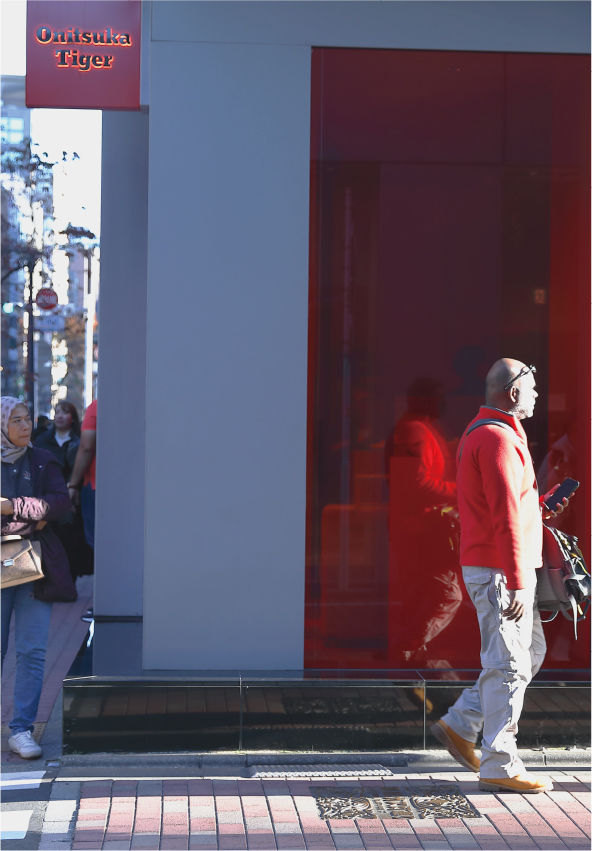
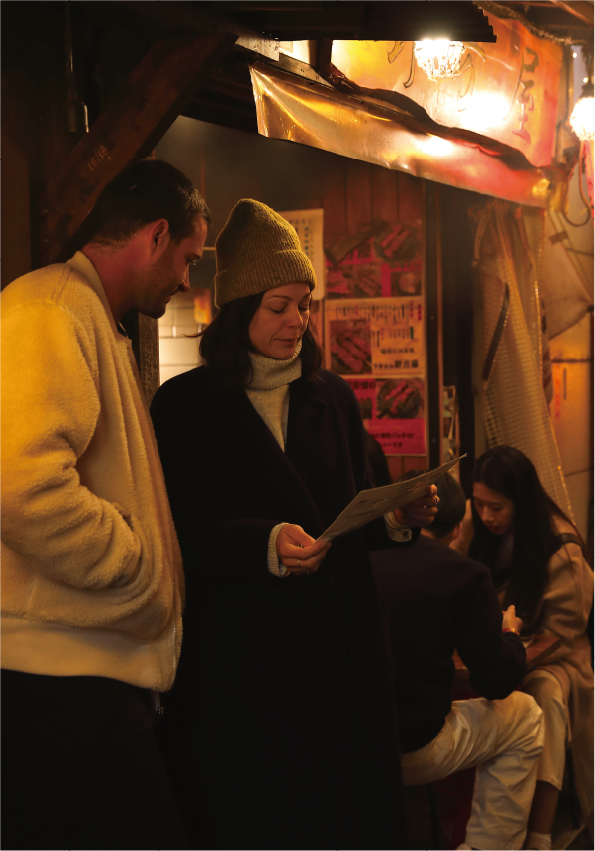
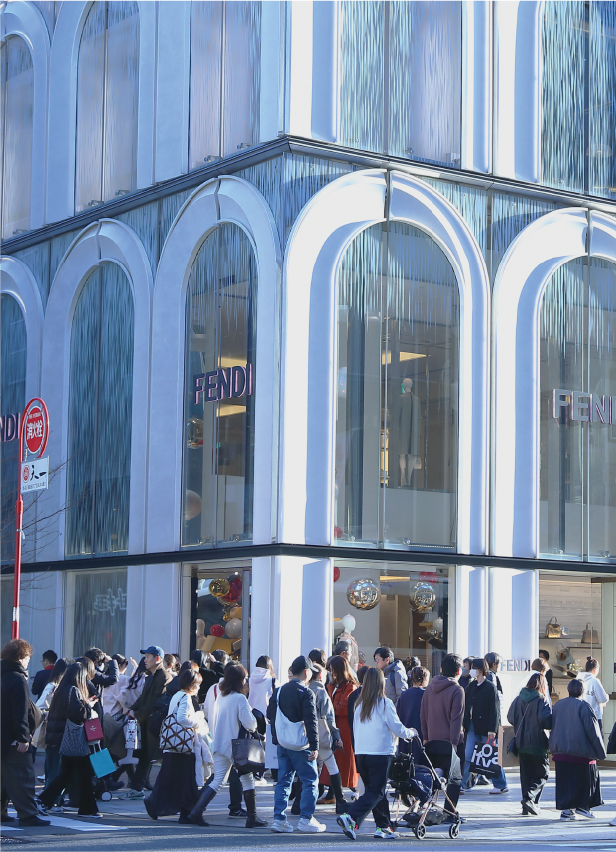
“はまっこ留学” とは横浜市が主催しているプログラム。円安の影響などで海外へ留学しにくくなったいま、それだったら横浜に多く住む外国人宅に留学しようと、1泊2日のホームステイをする。つまり、日本人が日本へ留学する。
それでいくと、日本各地で外国人と出会えるのは一種の海外旅行体験のようなもの。多様性がいわれる時代にあって、島国である日本にいろいろな人種、国籍の人たちがやって来るのはダイバーシティインクルージョンという観点からもウエルカム、ですよね。
日本は観光立国を目指している。観光庁のホームページには観光立国推進基本法なるものもある。歴史があり、自然があり、ヘルシーで美味しい食があり、アニメもある。さらに安心で安全で清潔な国を、安く旅行できる。インバウンドの観光客はますます増える、そのことを大いに歓迎したいと思う。
With the yen’s decline making overseas study challenging, this initiative offers a 2-day, 1-night homestay with foreign residents in Yokohama as a domestic alternative. It allows Japanese people to “study abroad” within Japan, turning encounters with foreigners into a kind of international travel experience.
In this era that values diversity, the arrival of people from various races and nationalities to an island nation like Japan is certainly welcome from a diversity and inclusion perspective.
Japan is striving to become a tourism-oriented nation, as highlighted by the Tourism Nation Promotion Basic Law on the Japan Tourism Agency’s website. Japan boasts history, nature, healthy and delicious cuisine, and anime, and it’s a safe, clean, and affordable country to travel in. The number of inbound tourists will only continue to grow, and that is something to be wholeheartedly welcomed.


